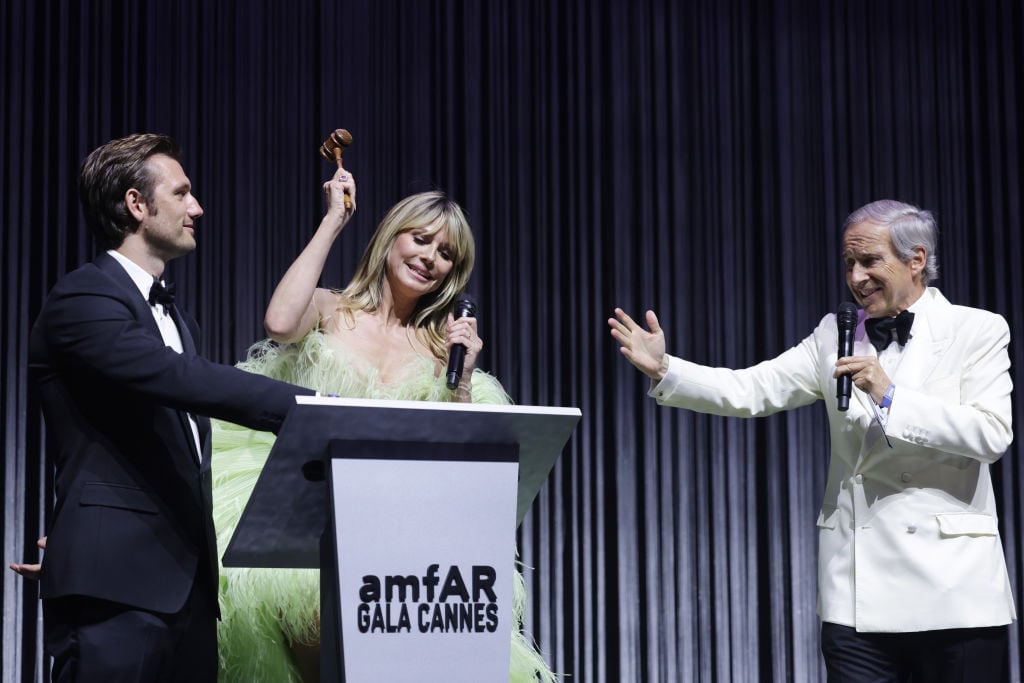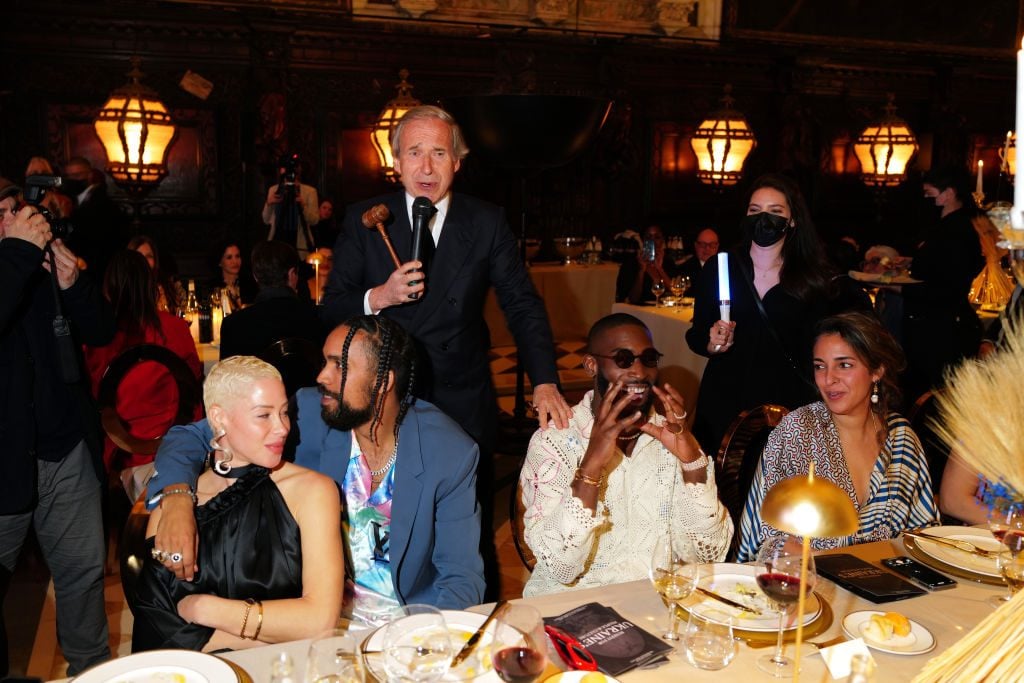The Hammer
Simon de Pury on Why We Urgently Need to Find Future-Proof Models for Charity Auctions and Fundraising Events
Commercial auctions successfully adapted to the new reality, but charity galas and fundraisers are a different beast.

Commercial auctions successfully adapted to the new reality, but charity galas and fundraisers are a different beast.

Simon de Pury

Every month in The Hammer, art-industry veteran Simon de Pury lifts the curtain on his life as the ultimate art-world insider, his brushes with celebrity, and his invaluable insight into the inner workings of the art market.
When at the start of the pandemic the whole world went into lockdown and even artworks themselves couldn’t be shipped anywhere, the auction market was quite fast in adapting to the completely new situation. In two and a half years the auction houses made more technological strides forward than during the two preceding decades. The main sale rooms began to look like TV studios filled with lots of equipment but no physical audience. The demonstration was successfully made that the vast majority of works of art are being acquired by people who didn’t have the chance to see the works physically before the auctions. Condition reports made by professional conservators and top quality images on iPhones, iPads or computers gave buyers the necessary comfort. It was no longer necessary for auction house specialists to ceaselessly travel around the world and to wine and dine their clients in the best restaurants. There was no need any more for super heavy vanity catalogs to be produced and couriered to each client’s main three residences at vast cost not just to the environment but also to the auction firms themselves.
As we embark on the summer season Covid seems to be like a long distant memory, a blast from the past. Exactly as we do as individuals when we have survived a very stormy and challenging period in our own lives, we want to forget about it as fast as possible and revert to the behavior we had before. The auction rooms are even more jam packed with collectors, dealers, advisors and socialites than before Corona. Art fairs that couldn’t take place during the pandemic are attracting record crowds.
The pandemic caused much bigger challenges to institutions whether medical, academic or cultural that depend to a large degree on their capacity to raise funds during charity auctions and galas. I remember vividly my first commercial auction that I conducted fifty years ago at Sotheby’s in their main sale-room at New Bond Street in London. It was a few years later that I was asked to conduct my first charity auction.

Alex Pettyfer, Heidi Klum and Simon de Pury speak on stage during the amfAR Cannes Gala 2023 at Hotel du Cap-Eden-Roc on May 25, 2023 in Cap d’Antibes, France. Photo by Pascal Le Segretain/amfAR/Getty Images for amfAR.
I rapidly realized that the skills required of an auctioneer at a philanthropic event are quite different from those at a “regular” auction. In both cases the task of the person conducting the auction is to obtain the highest possible price at the time of the sale. The people attending commercial auctions usually do so with the clear intent of acquiring one or more works that are being offered. The guests attending a charity gala have usually already paid substantial funds for a table or two seats and come essentially in order to have a good time. The more fun they will have on the night, the more they will want to impress some of the sometimes very attractive and elegant other guests and the more they will be generous during the auction.
The annual budget of an institution will depend on the outcome of the charitable auction which means that it is of critical importance. The seriousness of it all should however in no way interrupt or detract from the general entertainment of the event. This allows you as an auctioneer to be more theatrical and flamboyant and to hopefully use a fair dose of humor. It is for that reason maybe that the chief and principal auctioneers at the main auction firms are often not their main charity auctioneers.
When I resigned over ten years ago from Phillips de Pury & Company I thought it implied the end of my holding the hammer during auctions. I wasn’t overly perturbed by it since dealing and working with art has always been my prime motivation. Little did I realize that far from putting my gavel away I would be asked to conduct charity auctions all over the world. So much so that in 2019 I conducted 36 such sales. In 2020 when Covid struck I only wielded the hammer four times. This year I am back to or even beyond pre pandemic levels and there is hardly a week that passes without me having to go somewhere to sing for my supper.

Kennedy Yanko, Samuel Kareem, Simon de Pury and Tinie Tempah attend the Charity Gala for Ukraine people and culture at Scuola Grande Di San Rocco on April 21, 2022 in Venice, Italy. Photo by Daniele Venturelli/Getty Images.
Most of the charities that I support were faced with serious shortcomings in their fundraising efforts during Corona. Three or four times virtual galas were planned where everyone would have attended an entertainment program from home, they could have dressed up for the occasion and alcohol and food sponsors were prepared to supply them with a special menu sent to their domiciles. Each time the organizers had to cancel shortly before the scheduled events presumably because too few potential buyers had shown any interest. Technology was not quite advanced enough to translate the excitement of a live gala event to the living rooms. Online sales couldn’t quite replicate the fun and sexiness of the real thing.
This is one of the reasons that prompted me during the pandemic to try and develop a system where an avatar, caricature of myself, would conduct an auction. Instead of just seeing numbers going up on a screen you would hear my voice that hopefully could convey tremendous excitement and see my avatar gesticulating, hammer in hand, while bidders would type their bids onto their iPhones. I naively assumed that this meant I could lie on a beach under coconut trees somewhere while my avatar did my job. After all, when while driving my car I listen to the lovely female voice of my GPS telling me when to go left or right, there isn’t a lady actually lying in my car doing it in actual time. Despite the omnipresent talk of Artificial Intelligence and its progress at the speed of light, I actually have to climb into a kind of space suit, put on a very uncomfortable helmet with a camera filming my every move so that my avatar can replicate my gestures and hitting the hammer.
Simon de Pury’s digital avatar conducting a primary market aucton on de-PURY.com. Image courtesy Simon de Pury.
At de PURY we have four such online auctions led by my avatar in the pipeline at the moment: CREATE – 21st Century Architecture and Design on July 26, FIRE – Contemporary Glass & Ceramics on August 22, PARADISE LOST – Nature in Contemporary Art on September 20 and KAWAII – Cuteness in Contemporary Art on October 4…I will, or rather my avatar will, conduct these in the way described above. It is my hope however that for the multiple themes I have in mind for subsequent sales, you and other buyers will be able to pick from a selection of avatars. It can either be mine (which for me has the advantage that I don’t need to worry about additional wrinkles or less hair) or three or four other avatars of different genders, colors and ages.
While the four sales mentioned above are commercial, for profit initiatives, three percent of the total hammer price for each auction will be donated to the Design Department of the MoMA, the V&A, the Prince Albert II of Monaco Foundation and the Save the Children Fund respectively. None of us know what the future holds, however the pandemic and the many other challenges we face at the moment, have shown us that any business selling non essential items for survival should include a charitable component.
Simon de Pury is the former chairman and chief auctioneer of Phillips de Pury & Company, former Europe chairman and chief auctioneer of Sotheby’s, and former curator of the Thyssen-Bornemisza Collection. He is now an auctioneer, curator, private dealer, art advisor, photographer, and DJ. Instagram: @simondepury